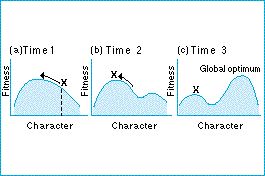Shifting balance theory

The shifting balance theory of evolution was an attempt by Wright to model evolution using both drift and selection.
Wright suggested that random drift could play a creative role in overcoming the tendency of natural selection to become stuck at local fitness peaks on an adaptive landscape.
• Finding the global peak:
Drift will tend to make the population gene frequencies 'explore' around their present position; the population could, by drift, move from a local peak to explore the valleys of the fitness surface. Once it had explored to the foot of another hill, natural selection could start it climbing uphill on the other side. With the processes of drift and selection, a population would be more likely to reach the global peak than if it was under the exclusive control of the locally maximizing process of natural selection.
• Subdivided populations:
Wright's full shifting balance theory also included subdivided populations, multiplying the chance that one of them within the whole population would find the global peak. If the members of a sub-population at the highest peak were better adapted, they could produce more offspring; they would also produce more emigrants to the other sub-populations. Those other sub-populations would then be taken over by the superior immigrant genotypes. Thus the whole species would evolve to the higher peak.
Figure: populations can find themselves trapped on local peaks on a fitness landscape. Wright's theory is a possible means by which populations can cross valleys and thereby reach the optimum fitness.
| Next |



